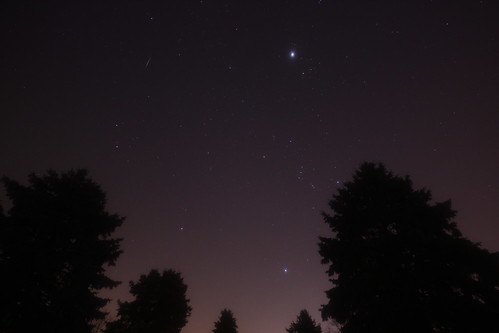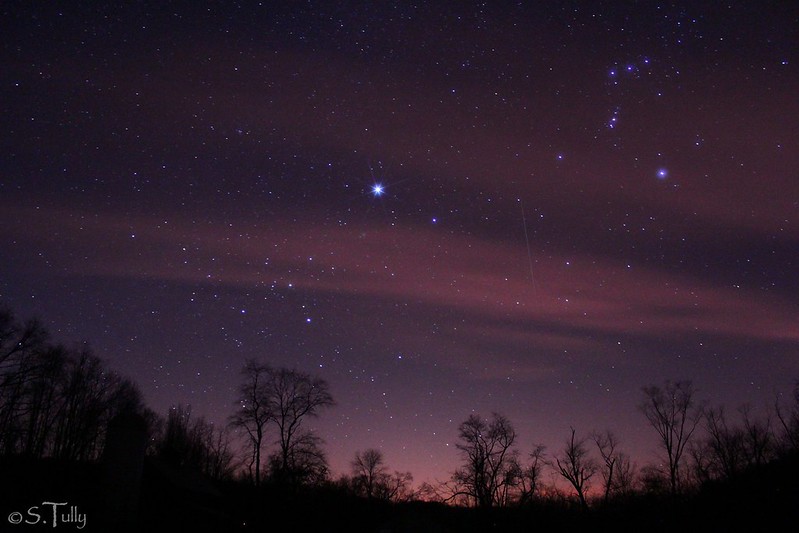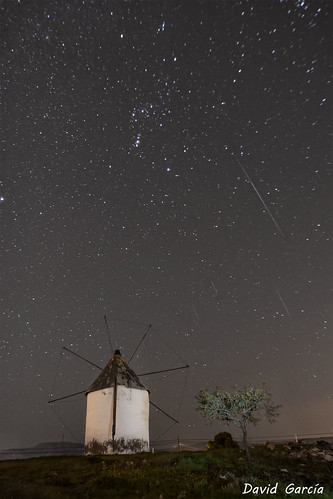Universe Today | VirtualAstro | 2012 Dec 04
The Geminid Meteor Shower is the grand finale of astronomical events in 2012 and is usually the most reliable and prolific of the annual meteor showers.Click to play embedded YouTube video.
This year we are in for a special treat as the Moon will be absent when the Geminids are at their peak on the evening of the 12th/ 13th of December. This means that the sky should be at its darkest when the shower is expected, and many more of the fainter meteors may be seen.
The Geminid meteor shower is expected to yield in excess of 50 meteors (shooting stars) per hour at peak for those with clear skies, the meteors it produces are usually bright with long persistent trains. If observing opportunities aren’t favorable or possible on the 12th/ 13th, meteor watchers can usually see high meteor activity a day or so either side of the peak.
As well as being the grand finale of 2012, the Geminids are special in another way. Unlike the majority of all the other annual meteor showers the Geminids are thought to be from an object known as 3200 Phaethon – an asteroid not a comet.
To celebrate this long anticipated event, there will be the Geminid Meteorwatch and anyone with an interest in the night sky can join in on Twitter, Facebook and Google+. The event will be an excellent opportunity to learn, share information, experiences, images and more. Whatever your level of interest, wherever you are on the planet Meteorwatch will run for approximately four days. All you need to do is follow along using the #meteorwatch hashtag.
As well as the wealth of information exchanged and shared on Twitter and the other social media outlets, there are helpful guides and information available on Meteorwatch.org so you can get the most out of your #meteorwatch.
To get the ball rolling there is a Hollywood style trailer for the event, purely as a bit of fun and for people of all walks of life to feel inspired and to go outside and look up. You don’t need a telescope or anything, just your eyes and a little bit of patience to see a Geminid meteor.
Geminid Meteor Shower Coming on December 13–14
Sky & Telescope | Alan MacRobert | 2012 Dec 05
If it’s clear late Thursday night, December 13th, 2012, keep a lookout high overhead for the shooting stars of the Geminid meteor shower. “The Geminids are usually one of the two best meteor showers of the year,” says Alan MacRobert, senior editor at Sky & Telescope magazine. “They may beat out the Perseids of August.” This year's showing has the added benefit of reduced celestial competition — thanks to the new Moon, no moonlight will interfere with meteor counting.
Under a clear, dark sky, you may see a shooting star every minute from 10 p.m. local time Thursday until dawn Friday morning. If you live under the artificial skyglow of light pollution the numbers will be less, but the brightest meteors will still shine through.
Lower counts of Geminid meteors should be visible earlier that evening, and a few should also flash into view on the nights of December 11, 12, and 14.
To watch for meteors, you need no equipment other than your eyes. Find a dark spot with an open view of the sky and no glaring lights nearby. Bundle up as warmly as you can in many layers. “Go out late in the evening, lie back, and gaze up into the stars,” says Sky & Telescope editor in chief Robert Naeye. “Relax, be patient, and let your eyes adapt to the dark. The best direction to watch is wherever your sky is darkest, probably straight up.”
Geminids can appear anywhere in the sky. Small ones appear as tiny, quick streaks. Occasional brighter ones may sail across the heavens for several seconds and leave a brief train of glowing smoke.
If you trace each meteor’s direction of flight backward far enough across the sky, you’ll find that this imaginary line crosses a spot in the constellation Gemini near the stars Castor and Pollux. Gemini is in the eastern sky during evening and high overhead in the hours after midnight (for skywatchers at north temperate latitudes). This special spot is called the shower’s radiant. It’s the perspective point from which all the Geminids would appear to come if you could see them approaching from the far distance, rather than just in the last second or so of their lives as they dive into Earth’s upper atmosphere.
Rock Comet Meteor Shower
NASA Science News | Dr. Tony Phillips | 2012 Dec 09
Every year in mid-December, astronomers look up in the sky and witness a mystery. It announces itself with a flurry of shooting stars. For several nights in a row, dozens to hundreds of meteors per hour cut across the glistening constellations of winter, each one a little puzzle waiting to be solved.Click to play embedded YouTube video.
"It's the Geminid meteor shower--set to peak on Dec. 13th and 14th," says Bill Cooke of NASA's Meteoroid Environment Office. "Although the Geminids come every year, we still don't fully understand them."
Most meteor showers are caused by icy comets, which spew jets of meteoroids when they are heated by sunlight. The Geminids are different. The parent is not a comet but a weird rocky object named 3200 Phaethon.
When 3200 Phaethon was discovered in 1983 by NASA's IRAS satellite, astronomers quickly realized that they had found the source of the Geminids. The orbit of 3200 Phaethon was such a close match to that of the Geminid debris stream, no other conclusion was possible. Yet here was a puzzler: Everything about 3200 Phaethon suggests it is an asteroid.
In fact, 3200 Phaethon resembles main belt asteroid Pallas so much, it could well be a 5-kilometer chip off that 544 km block. "If 3200 Phaethon broke apart from asteroid Pallas, as some researchers believe, then Geminid meteoroids might be debris from the breakup," speculates Cooke.
There is, however, another possibility: Perhaps 3200 Phaethon is a "rock comet."
A "rock comet" is a new kind of object being discussed by some astronomers. It is, essentially, an asteroid that comes very close to the sun--so close that solar heating scorches dusty debris right off its rocky surface. Rock comets could thus grow comet-like tails made of gravely debris that produce meteor showers on Earth.
Could this be the answer?
To test the idea, researchers turned to NASA's twin STEREO spacecraft, which are designed to study solar activity. In June 2009, STEREO watched 3200 Phaethon passing only 15 solar diameters from the sun's surface. What happened next surprised UCLA planetary scientists David Jewitt and Jing Li, who analyzed the data.
"3200 Phaethon unexpectedly brightened by a factor of two," they wrote. "The most likely explanation is that Phaethon ejected dust, perhaps in response to a break-down of surface rocks (through thermal fracture and decomposition cracking of hydrated minerals) in the intense heat of the Sun."
So, according to the STEREO observations, 3200 Phaethon does behave like a rock comet.
The “rock comet” hypothesis is compelling, but Jewett and Li point out a problem: The amount of dust 3200 Phaethon ejected during its sun-encounter added a paltry 0.01% to the mass of the Geminid debris stream, not enough to keep the debris stream stocked up with meteoroids for the annual display of shooting stars. 3200 Phaethon is not spewing enough dust to account for the Geminids.
Could the rock comet have been more active in the past....? "We just don't know," says Cooke.
Forecasters expect Geminid meteor rates to top 100 per hour when the shower peaks on the moonless nights of Dec. 13th and 14th, 2012. Cooke encourages sky watchers to go out, look up, and savor the mystery.
Activity in Geminid Parent (3200) Phaethon - David Jewitt and Jing Li
- Astronomical Journal 140(5) 1519 (2010 Nov) DOI: 10.1088/0004-6256/140/5/1519















